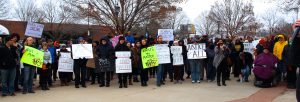
For nearly 20 years now, I’ve met with relatives of prisoners freighted to rural prisons. For working class families, the long distance phone calls and road trips required to keep in touch with an incarcerated loved one are hard to manage and put important human relationships at risk. It’s a problem that gets resolved through broad public awareness and popular dissent. What’s the most pragmatic, sustainable way to make that happen?
Even as mental health providers caution that prisoners fare better while incarcerated close to home, where frequent visits from family and friends are possible, the majority of the prison population is transported 100 miles or more from their communities of origin. Exiled from everything and everyone they know, these prisoners lack for nearby advocates, leaving them with few options when they face harsh treatment and civil rights violations.
In response, artists, activists and citizens are undertaking a cooperative endeavor to end mass incarceration, one that spans the urban-rural divide. We organize around everything from releasing aging people from prison to setting up best practices around how prisons impact and are impacted by environmental issues. But these types of enterprises require long-term grantmaking from philanthropists interested in bridging two seemingly disparate locales. Linking urban and rural communities is complex work that takes time, but it pays dividends in optimizing strategic grassroots power.
The vast majority of our country’s prisons are disproportionately filled with men and women of color from struggling urban centers, and are disproportionately located in white, economically-hard-hit rural areas. Urban criminalization and rural exploitation are tandem oppressions, and for as long as our criminal justice system functions as a kind of Stanford Prison Experiment – pitting people against one another in false games of power and fear – the brutality will continue to be routine.
The urban-rural dichotomy is mostly contrived. Talk of out-of-the-way backwaters and insular cities belies the deeper reality: urban and rural Americans live in comparable worlds bound by common values. Very few rural residents are farmers. Instead, they live civic lives similar to those of their urban counterparts but on a smaller scale. By the same token, both communities battle social pathologies like poverty and the drug war.
Rural communities are often depicted as homogeneous, but during the last couple of decades, they’ve grown more diverse. And they’ve always included vibrant communities of color. As Beyoncé Knowles notes in her much-discussed song and video “Formation,” rural Black art has often been a catalyst for the American identity and culture we’ve most benefitted from.
That’s not to minimize what’s emerging as a remarkable urban-rural political divide. As Josh Kron writes in this The Atlantic magazine article, presidential election data indicate that polarizing, ideological rifts along party lines increasingly manifest themselves geographically, giving rise to Democratic cities and Republican states. Red and blue Americans seem to be rushing to their sides of the playing field: “Cities, year by year, have become drenched in more blue. Everywhere else is that much more red,” Kron writes. A recent Pew Research Center report referred to these us-and-them communities as “alien tribes.”
Yet criminal justice issues are one way to unite both sides in solidarity for change. Almost everyone has had an incarcerated relative, friend or acquaintance. As The Crime Report noted, surveys show that Republicans and Democrats favor prison reform equally.
Less than 1 percent of philanthropic funding flows toward rural counties. As philanthropic sources realize how important it is to strengthen inner-city justice movements that push back against systemic criminalization (something we need to see much more of), they’re slow to reach out to remote counties where the infrastructure for criminalization is largely built and people are increasingly subject to it (the bottoming out of rural towns means escalating arrest rates).
“We may have all come on different ships, but we’re in the same boat now,” Martin Luther King once said. That couldn’t be truer than for rural and urban communities facing down the prison industrial complex. Dedicating more foundation resources to networking rural and urban grassroots organizations is a simple step toward growing grassroots power and building a robust movement to end mass incarceration.
Nick Szuberla is executive director and co-founder of Working Narratives. Follow him on Twitter @NickSzuberla.


